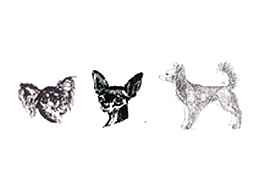Russian Toy (Russkiy Toy) (Long Haired) Breed Standard
Last updated: 22 Dec 2017
A breed standard is the guideline which describes the ideal characteristics, temperament, and appearance of a breed and ensures that the breed is fit for function with soundness essential. Breeders and judges should at all times be mindful of features which could be detrimental in any way to the health, welfare or soundness of this breed.

FCI Standard No 352 dated 5 December 2017
TRANSLATION: Anna Samsonova. Edited by Dr. Eugene Yerusalimsky
ORIGIN: Russia
DATE OF PUBLICATION OF THE ORIGINAL VALID STANDARD: 07.11.2017
UTILIZATION: Companion Dog
FCI CLASSIFICATION: Group 9 Companion and Toy dogs. Section 9 Continental Toy Spaniels and Russian Toys. Without working trial.
-
Group:
Group 1 (Toys)
-
History:
-
General Appearance:
The Standard of the Russian Toy (Russkiy Toy) (Long Haired) is the same as the Standard of the Russian Toy (Russkiy Toy) (Smooth Haired) with the exception of the following:
-
Characteristics:
-
Temperament:
-
Head And Skull:
-
Eyes:
-
Ears:
-
Mouth:
-
Neck:
-
Forequarters:
-
Body:
-
Hindquarters:
-
Feet:
-
Tail:
-
Gait/Movement:
-
Coat:
Long-haired: Body and neck are covered with moderately long (3-5 cm), straight or slightly wavy hair, close-lying. Hair on the head and on the front part of limbs is short and close -lying. Distinct feathers on rear side of limbs and the tail. Ears are covered with thick, long hair forming a fringe. In adult dogs the fringe, should completely hide the outer edges and tips of the ears. Body hair should not be tousled or fluffy.
-
Colour:
-
Sizes:
-
Faults:
Any departure from the foregoing points should be considered a fault and the seriousness with which the fault should be regarded should be in exact proportion to its degree and its effect upon the health and welfare of the dog.
-
Notes:
 For owners
For owners
 Members
Members
 Dogs Australia is a not-for-profit organisation advocating for the preservation of purebred dogs through ethical breeding.
It champions the highest standard of animal welfare through education and fostering dog-loving communities.
Internationally recognised and established in 1958 as the Australian National Kennel Council (ANKC),
the organisation promotes responsible dog ownership; maintains the ORCHID* heritable canine diseases database;
funds research into canine diseases; and supports state and territory-based member bodies.
Dogs Australia promotes breed conformation shows and community sports for dogs that fulfil a breed’s natural instincts.
Dogs Australia is a not-for-profit organisation advocating for the preservation of purebred dogs through ethical breeding.
It champions the highest standard of animal welfare through education and fostering dog-loving communities.
Internationally recognised and established in 1958 as the Australian National Kennel Council (ANKC),
the organisation promotes responsible dog ownership; maintains the ORCHID* heritable canine diseases database;
funds research into canine diseases; and supports state and territory-based member bodies.
Dogs Australia promotes breed conformation shows and community sports for dogs that fulfil a breed’s natural instincts.







